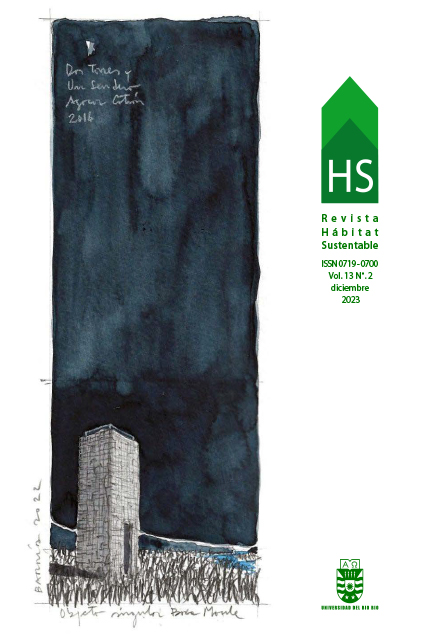Fabricação de argamassas leves com perlita e cal aplicadas em painéis com matriz de resíduos de palha de arroz
DOI:
https://doi.org/10.22320/07190700.2023.13.02.06Palavras-chave:
reboco, argamassa, palhaResumo
O objetivo desta pesquisa é projetar e caracterizar argamassas de reboco à base de perlita e cal produzidas no Equador, com uma resistência à compressão mínima de 6,89 MPa, conforme estabelecido pelo IRC 2018. Isso, para ser aplicado em painéis feitos com palha de arroz. Para isso, foram projetadas duas misturas padrão. Na primeira, a areia é usada como agregado fino, enquanto na segunda, é usada perlita. A partir de cada uma delas, são obtidas 8 misturas adicionais, nas quais o cimento é substituído por cal (em volume) em diferentes porcentagens. Foram feitos 270 corpos de prova para avaliar a resistência à compressão e a densidade das argamassas em 1, 3, 7, 28 e 50 dias. A argamassa feita com perlita e composta por 50% de cal, 50% de cimento e aditivo, atingiu uma resistência de 7,22 MPa, com densidade de 1,45 g/cm³. Quando essa mistura foi aplicada aos painéis feitos com palha de arroz, ela resultou em um aumento de até 68% na resistência à compressão.
Downloads
Referências
APOSTOLOPOULOU, M., BAKOLAS, A. & KOTSAINAS, M. (2021). Mechanical and physical performance of natural hydraulic lime mortars. Construction and Building Materials, 290(1), 1-14. https://doi.org/10.1016/j.conbuildmat.2021.123272
APRIANTI, A. (2017). A huge number of artificial waste material can be supplementary cementitious material (SCM) for concrete production e a review part II. Journal of Cleaner Production, 142, 4178-4194. https://doi.org/10.1016/j.jclepro.2015.12.115
ARTIGAS, V., QUINTANA, M., POSITIERI, M. & OSHIRO. A. (2022). Efectos de la utilización de desecho polvo de perlita natural en hormigones autocompactantes coloreados. Concreto & Construções, XLIX(105), 42-47. http://dx.doi.org/10.4322/1809-7197.2022.105.0003
CASCONE, S., RAPISARDA, R. & CASCONE, D. (2019). Physical Properties of Straw bales as a construction material. Sustainability, 11(12), 1-19. https://doi.org/10. 3390/su11123388
ECHEVERRÍA, M., FLORES, V. & DEL RÍO, J. (2022). Reuse of banana fiber and peanut shells for the design of new prefabricated products for buildings. Revista de la Construcción, 21(2), 462-472. https://doi.org/10.7764/RDLC.21.2.461
El MIR, A., NEHME, S. & ASSAAD, J. (2020). Durability of self-consolidating concrete containing natural waste, Heliyon, 6(1), 1-10. https://doi.org/10.1016/j.heliyon.2020. e03165
ESBA. (2021, December 22). UP STRAW: Interreg Project | ESBA. https://strawbuilding.eu/up-straw-interreg-project/
FERNANDEZ, F., GERMINARIO, S., BASILE, R. & MONTAGNO R. (2020). Development in construction Industry Development of Eco-Friendly and Self-Cleaning Lime-Pozzolan Plasters for Bio-Construction and Cultural Heritage. Buildings, 10(10), 172, 1-12. https://doi.org/10.3390/buildings10100172
HERMIDA, Á. (2021, February 15). Cemento y crisis climática: cómo el material supremo calienta el planeta. elconfidencial.com. https://www.elconfidencial.com/medioambiente/ciudad/2021-02-15/cemento-gases-efecto-invernadero-calentamiento_2944723/
INTERNATIONAL CODE COUNCIL (ICC). (2018). 2018 INTERNATIONAL RESIDENTIAL CODE (IRC)|ICC DIGITAL CODES. https://codes.iccsafe.org/content/IRC2018/appendix-s-strawbale-construction
MARTÍNEZ S., C. (2021). Estudio y aplicaciones de las construcciones con fardos de paja [Trabajo final de Grado]. Universidad de Valladolid. https://uvadoc.uva.es/bitstream/handle/10324/38967/TFG-A-170.pdf?sequence=1&isAllowed=y
MENDOZA, J. & VANGA, M. (2021). Realidad y expectativa sobre la construcción sostenible en Ecuador. Revista San Gregorio, 1(43), 197-209. https://revista.sangregorio.edu.ec/index.php/REVISTASANGREGORIO/article/view/1116/14-JHON22
MINISTERIO DE AGRICULTURA Y GANADERÍA DE ECUADOR. (2022). Sistema de información pública agropecuaria [SIPA]. sipa.agricultura.gob.ec. http://sipa.agricultura.gob.ec/
MUNTANI, G., AZZOLUNO, C., MACRÍ, M. & MANCUSO, S. (2020). Straw Buildings: A Good Compromise between Environmental Sustainability and Energy-Economic Savings. Applied Sciences, 10(8), 1-19. https://doi.org/10.3390/app10082858
PAHLAVAN, P., MANZI, S., SANSONETTI, A. & CHIARA, M. (2018). Valorization of organic additions in restorative lime mortars: Spent cooking oil and albumen. Construction and Building Materials, 181, 650-658. https://doi.org/10.1016/j.conbuildmat.2018. 06.089.
PAVÍA, S., & BRENNAN, O. (2018). Portland Cement-Lime Mortars for Conservation. In J. Hughes, J. Válek, & C. J. W. P. Groot (Eds.), Historic Mortars: Advances in Research and Practical Conservation (pp. 129–142). Springer. https://doi.org/10.1007/978-3-319-91606-4_10
STEPHAN, A. & ATHANASSIADIS, A. (2018). Towards a more circular construction sector: Estimating and spatialising current and future non-structural material replacement flows to maintain urban building stocks. Resources, Conservation and Recycling, 129, 248-262. https://doi.org/10.1016/j.resconrec.2017.09.022
SUDHARSAN, N. & SIVALINGAM, K. (2019). Potential Utilization of Waste Material for Sustainable Development in construction Industry. International Journal of Recent Technology and Engineering, 8(3), 3435-2438. https://doi.org/10.35940/ijrte.c5062.098319
TESLÍK, J. (2021). Analysis of the fire properties of blown insulation from crushed straw in the buildings. Materials, 14(15), 1-12. https://doi.org/10.3390/ma14154336.
VIERA, P. & ACERO, M. (2022). Diseño de un mortero a partir de la caracterización de cal producida y comercializada por 5 proveedores en Ecuador, Novasinergia, 5 (2), 158-173, https://doi.org/10.37135/ns.01.10.09
WALKER, P., THOMSON, A., & MASKELL, D. (2020). Straw bale construction. In K. A. Harries & B. Sharma (Eds.), Nonconventional and vernacular construction materials: Characterisation, Properties and Applications. (2nd Edition, pp. 189–216). Woodhead Publishing. https://doi.org/10.1016/b978-0-08-102704-2.00009-3
YIN, X., LAWRENCE, M. & MASKELL, D. (2018). Straw bale construction in northern China – Analysis of existing practices and recommendations for future development. Journal of Building Engineering, 18, 408-417. https://doi.org/10.1016/j.jobe.2018.04.009
ZHANG, D., ZHAO, J., WANG, D., XU, C., ZHAI, M. & MA, X. (2018). Comparative study on the properties of three hydraulic lime mortar systems: Natural hydraulic lime mortar, cement-aerial lime-based mortar and slag-aerial lime-based mortar. Construction and Building Materials, 186, 42-52. https://doi.org/10.1016/j.conbuildmat.2018.07.053
Downloads
Publicado
Como Citar
Edição
Secção
Licença
Direitos de Autor (c) 2023 Henry Ramos-Rodriguez, Paulina Viera-Arroba

Este trabalho encontra-se publicado com a Licença Internacional Creative Commons Atribuição-CompartilhaIgual 4.0.
O conteúdo dos artigos publicados em cada número do Habitat Sustentável é da exclusiva responsabilidade dos autores e não representa necessariamente o pensamento ou compromete a opinião da Universidad del Bío-Bío.
Os autores mantêm os seus direitos de autor e concedem à revista o direito de primeira publicação da sua obra, que está simultaneamente sujeita à Licença de Atribuição Creative Commons CC BY-SA que permite a outros partilhar, transformar ou criar novo material a partir desta obra para fins não comerciais, desde que a autoria e a primeira publicação nesta revista sejam reconhecidas, e as suas novas criações sejam licenciadas sob os mesmos termos.











 Programa de Informação Científica/Concurso Fondos de Publicación de Revistas Científicas 2018/ Proyecto Mejoramiento de Visibilidad de Revistas UBB (Código:FP180007)
Programa de Informação Científica/Concurso Fondos de Publicación de Revistas Científicas 2018/ Proyecto Mejoramiento de Visibilidad de Revistas UBB (Código:FP180007)





